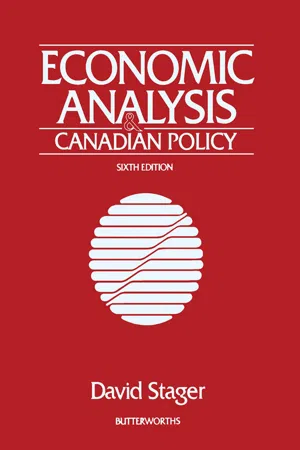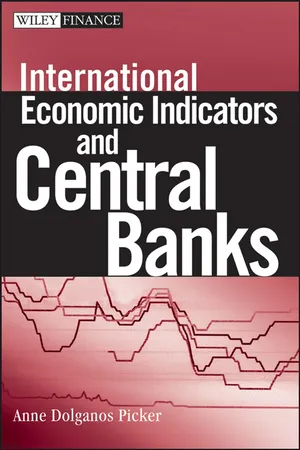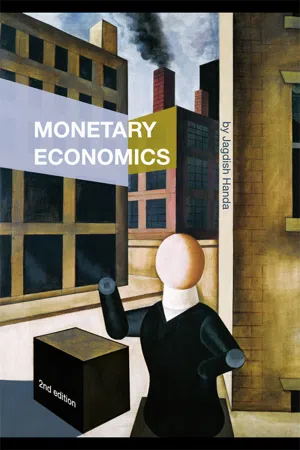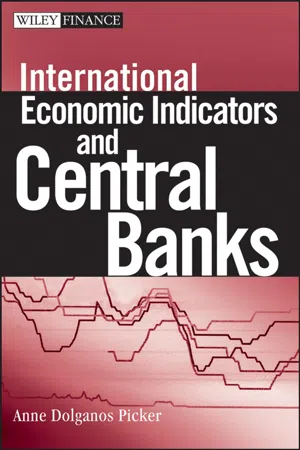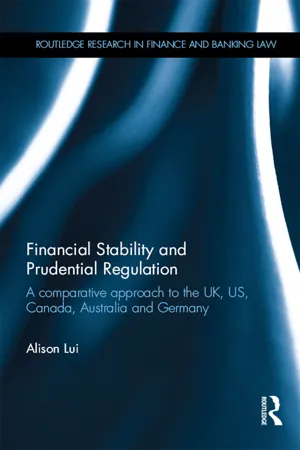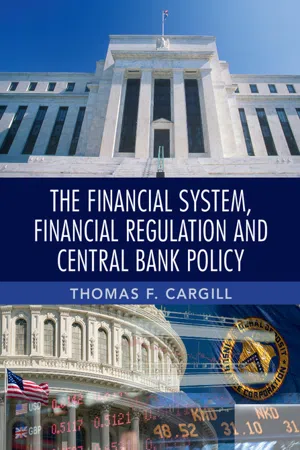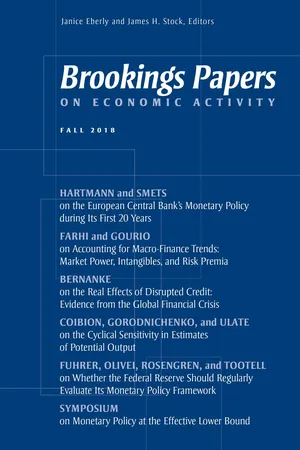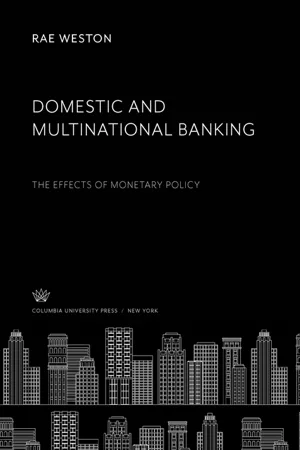Economics
Bank of Canada
The Bank of Canada is the country's central bank, responsible for monetary policy, issuing currency, and promoting a stable and efficient financial system. It conducts monetary policy to control inflation and promote economic stability, and it also acts as the government's fiscal agent, managing public debt and foreign exchange reserves.
Written by Perlego with AI-assistance
Related key terms
1 of 5
12 Key excerpts on "Bank of Canada"
- eBook - PDF
- David Stager(Author)
- 2013(Publication Date)
- Butterworth-Heinemann(Publisher)
^ The regulation of the money supply to stabilize employment, prices, and the foreign exchange rate of the dollar is the main responsibility of the Bank of Canada. The Bank does, however, have a number of other important functions. These flow from its dual role as the government's bank and the bankers' bank. T h e Government's Economic Advice In its role as the federal government's bank, the Bank Bank of Canada provides economic advice to the government, through meetings of Bank officials with people from the federal Department of Finance, and more formally through the Governor's annual report and occasional speeches. Government's Deposits The balance sheet of the Bank of Canada as presented in Table 7.2 illustrates some of the other ways in which the Bank serves the federal government. Some of the government's deposits are held at the Bank of Canada, although a comparison of Tables 7.2 and 7.3 shows that at the end of 1986, the government held only $100 million at the Bank of Canada, while it held $2 bilHon at the chartered banks. Although this ratio varies somewhat, the larger part of federal government funds are held at the chartered banks. 5 Submission by the Bank of Canada to the Royal Commission on Banking and Finance, 31 May 1962, p. 23. 6 One major exception to this practice was the growing conflict between the views of the Governor and the Minister of Finance in 1961, which ended with the resignation of the Governor. - Anne Dolganos Picker(Author)
- 2011(Publication Date)
- Wiley(Publisher)
In March 1935, the Bank was open for business as a privately owned institution, with shares sold to the public. But this did not last long. A new government nationalized the Bank, and in 1938 it became publicly owned and remains that way today. The Bank of Canada Act, which defines the Bank’s functions, has been amended many times but the preamble has not changed. The Bank still exists “to regulate credit and currency in the best interests of the economic life of the nation.”The Bank’s organization integrated new functions with those that already existed elsewhere. When the Bank opened, it became the sole issuer of Canadian currency after banknote operations were transferred from the Department of Finance. Among the many new features of the Bank was a Research Division, which was established to provide information and advice on financial developments and on general business conditions at home and abroad. The Foreign Exchange Division and the Securities Division became operative almost immediately, though the transfer of the Public Debt Division from the Department of Finance was delayed until suitable quarters were available. This did not occur until 1938, following completion of the present Bank of Canada building in Ottawa. The Bank also has regional offices in Vancouver, Calgary, Toronto, Montréal, and Halifax in Canada and, like the Bank of Japan and the Reserve Bank of Australia, a New York City office.The Bank is structured like many corporate entities. Overall responsibility for business affairs rests with its Board of Directors, and the Governor of the Bank is the Chief Executive Officer and Chairman of the Board. Collective responsibility for management of the Bank is in the hands of its Governing Council.MONETARY POLICYThe Bank carries out monetary policy by influencing short-term interest rates by setting the overnight target. This in turn affects monetary conditions—that is, the impact of short-term interest rates and the Canadian dollar’s exchange rate on the economy. The transmission of monetary policy occurs as changes in monetary conditions affect the demand for goods and services. Lower interest rates, for example, tend to increase spending and reduce savings, and a lower dollar can boost exports and hold back imports. Conversely, higher interest rates tend to curb domestic spending and a higher dollar tends to curb exports and encourage imports. Strong demand for Canadian goods and services puts upward pressure on prices if it exceeds the economy’s capacity. Changes in monetary conditions affect inflation only indirectly and are usually felt over a period of 18 months to two years.- Panicos Demetriades(Author)
- 2019(Publication Date)
- Agenda Publishing(Publisher)
1 Central bank roles: historical context From financing wars to inflation targeting: a brief history of central banksCentral banks are institutions that issue currency, provide banking services to governments and commercial banks and have responsibility over monetary policy, including setting short-term policy rates (at which they provide short-term liquidity to commercial banks through monetary operations). Often central banks have responsibilities relating to financial stability, which sometimes include regulating and supervising commercial banks and, more recently, resolving banks that are failing.Central bank legal frameworks vary considerably from country to country, largely reflecting differences in attitudes shaped by diverse historical experiences. A key feature of the European Central Bank (ECB), unlike the United Kingdom’s Bank of England (BoE) and the United States’ Federal Reserve (the Fed), is that it is explicitly prohibited by the Treaty on the Functioning of the European Union (article 123 – known as the monetary financing prohibition) from financing government deficits. Moreover, although all three central banks have mandates in which price stability is central, price stability is the ECB’s overarching objective: it can support other goals, including financial stability, growth and employment, only to the extent that they do not interfere with price stability. By contrast, the Fed has a dual mandate set in law: it aims to maximize employment and stabilize prices (as well as moderate long-term interest rates). The Bank of England’s objectives are set annually by the government, however. Ever since the bank was granted operational independence, in 1997, the main aim of monetary policy has been the achievement of low and stable inflation; other government objectives, including employment and growth, have been subordinated to price stability – very much like the ECB. Nevertheless, although, in the BoE case, the mandate can be changed by the government in any given year, the ECB’s mandate cannot change without a revision in the TFEU; such a change requires unanimous agreement by all EU member states.- eBook - ePub
Towards North American Monetary Union?
The Politics and History of Canada's Exchange Rate Regime
- Eric Helleiner(Author)
- 2006(Publication Date)
- McGill-Queen's University Press(Publisher)
102 Soon after the bank began operations in March 1935, parliament also strengthened its ability to meet this goal by creating an exchange fund that the bank would manage.With these reforms, the country finally had the institutions to regulate the exchange rate more effectively. It is odd, then, that the bank did very little for the rest of the decade to take up this task. The Canadian dollar floated freely for the duration of the decade, and the exchange fund was hardly used up until the outbreak of war in 1939.103 How do we explain this inaction? One explanation is that the Canadian dollar’s free float was remarkably stable between 1934 and 1939 (see Figure 2 , page 42 ). While other countries with floating rates experienced considerable exchange rate volatility in the 1930s, the Canadian currency remained roughly at par with the US dollar and slightly below par with the pound throughout the period.104 This exchange rate stability was partly attributable to the stability of the US dollar-sterling exchange rate. Towers also attributed it to the pattern of equilibrating capital flows associated with the large number of optional payments bonds which, as he noted, was “a feature of our financial economy which is not found in any important degree in any other country.”105 In the late 1930s, Towers even argued that these equilibrating financial movements were generated only when the exchange rate was allowed to float freely. In other words, he cited the equilibrating pattern of capital flows as a reason not to intervene to influence the Canadian dollar’s value. When the Canadian dollar fell slightly below par with the US dollar in April 1938 and Towers was under pressure to manage the exchange rate more actively, he resisted this pressure with this argument: “A premium on U.S. dollars encourages capital and other movements which tend to reestablish equilibrium and therefore one should hesitate to oppose an upward movement in the U.S. dollar rate ... We, therefore, would not recommend any attempt now to stabilize the exchange rate at par, or at any definite level, either by direct intervention in the exchange market or by means of monetary policy (which would involve some degree of contraction).”106 - eBook - ePub
- Jagdish Handa(Author)
- 2008(Publication Date)
- Routledge(Publisher)
It is currently (2008) at 2 percent, along with a set range for acceptable fluctuations in inflation. The primary objective of monetary policy in Britain is now explicitly that of price stability and only secondarily growth and employment objectives. The implementation of monetary policy, such as the setting of the Bank rate, since 1997 has been left to the Bank and its Monetary Policy Committee. Goodhart (1989, 1995) provides an excellent statement of central banking from a British perspective. Evolution of the goals of the Bank of Canada In the late 1980s, the Governor of the Bank of Canada publicly argued that the mandate of the Bank should be changed to focus only on price stability as its mandated goal. The proposal was considered in 1992 by a parliamentary committee, which decided to leave the Bank’s mandate as it had been specified in the Bank of Canada Act of 1934, i.e. with a multiplicity of goals. However, several successive Governors of the Bank in the late 1980s and the 1990s have advocated and in practice consistently focused solely or mainly on the goal of price stability or a low inflation rate. Since 1991 the Bank has announced explicit targets, with an average of 2 percent and a range of 1 percent to 3 percent, for the core inflation rate. These targets have been set jointly by the Bank of Canada and the Government of Canada. 7 Movements in other variables such as the exchange rate and asset prices are taken into account to the extent that they affect the rate of current or future inflation. In the case of a deviation of the actual inflation from the 2 percent target, the Bank normally aims at bringing inflation back to its target over a six to eight-quarter period. The Bank uses a Monetary Conditions Index (MCI) (explained later in this chapter), which is a weighted sum of the interest rates and the exchange rate, as an operational guide. It uses the overnight loan rate for reserves as its operational target, with a range of 50 basis points - Robert Leeson(Author)
- 2009(Publication Date)
- Palgrave Macmillan(Publisher)
And if it does persist for another decade or more, it will constitute an impressive legacy for those who played a part in its evolution. References Bank of Canada. 1991. ‘Targets for Reducing Inflation’ Press Release reproduced in Bank of Canada Review, March, pp. 5–6. —— ‘Renewal of the Inflation Control Target: Background Information.’ Ottawa: Bank of Canada, May. Boessenkool, Kenneth J., David E. W. Laidler, and William B. P. Robson. 1996. ‘Devils in the Details: Improving the Tactics of Recent Canadian Monetary Policy.’ C. D. Howe Institute Commentary 79. April. William Robson 33 Boessenkool, Kenneth J., and William B. P. Robson. 1998. ‘Buried by a Falling Dollar: The Bank of Canada’s Misguided Interest Rate Hike Promises Recession.’ C. D. Howe Institute Backgrounder. August. Bothwell, Robert, Ian Drummond, and Edward English. 1981. Canada since 1945: Power, Politics and Provincialism. Toronto: University of Toronto Press. Brunner, Karl. 1984. ‘Monetary Policy and the Monetary Order.’ Reprinted in Karl Brunner and Alan Meltzer. Monetary Policy and Monetary Regimes. Rochester: University of Rochester Graduate School of Management. 1985. Clinton, Kevin. 2006. ‘Core Inflation at the Bank of Canada: A Critique.’ Queen’s Economics Department Working Paper, No. 1077. Kingston. May. Crow, John W. 1988. ‘The Work of Canadian Monetary Policy’ Eric J. Hanson Memorial Lecture delivered at the University of Alberta, Edmonton, January 8, 1988, reprinted in Bank of Canada Review (Spring). Crow, John W. 2002. Making Money: An Insider’s Perspective on finance, Politics, and Canada’s Central Bank. Toronto: Wiley. Freedman, Charles. 2000. ‘Monetary Policy Implementation: Past, Present and Future – Will Electronic Money Lead to the Eventual Demise of Central Banking?’ International Finance 3:2, 211–27. Friedman, Benjamin. 1999. ‘The Future of Monetary Policy: The Central Bank as an Army With Only a Signal Corps.’ International Finance 2:3, 321–38.- Anne Dolganos Picker(Author)
- 2007(Publication Date)
- Wiley(Publisher)
Neither the government nor the Bank targets any particular level for the currency, believing that this should be determined by the market. Over time, the value of the Canadian dollar is ultimately affected by economic fundamentals, such as inflation and interest rate levels, which in turn depend on Canadian monetary policy, the economic growth, and the competitiveness of its products. Since September 1998, the Bank no longer intervenes in foreign exchange markets to ensure an orderly market, but rather reserves such actions for times of major international crisis or a clear loss of confidence in the currency or in Canadian dollar–denominated securities. Intervention Prior to September 1998, Canada’s policy was to intervene systematically in the foreign exchange market to resist significant upward or downward pressure on the Canadian dollar. The policy was changed because interven- tion proved to be ineffective when resisting currency movements caused by changes in fundamental factors. Current policy is to intervene in foreign exchange markets on a discretionary, rather than a systematic, basis and only in the most exceptional of circumstances. Foreign exchange market intervention is conducted by the Bank, acting as agent for the federal government and using the government’s holdings of foreign currencies. For example, if the government and the Bank decided to moderate a decline in the Canadian dollar, the Bank would buy Canadian dollars in foreign exchange markets in exchange for other currencies, mainly U.S. dollars, which come from the Exchange Fund Account. This boosts demand for Canadian dollars and helps support the currency’s value. To make sure that the Bank’s purchases do not take money out of circulation and create a shortage of Canadian dollars, which in turn could put upward pressure on Canadian interest rates, the Bank sterilizes its purchases by Bank of Canada 79 redepositing the same amount of Canadian dollar balances in the financial system.- eBook - PDF
- John E. Marthinsen(Author)
- 2020(Publication Date)
- De Gruyter(Publisher)
This chapter deepened our understanding of the tools that central banks use to control their nations ’ (or currency areas ’ ) money supplies and credit conditions. This under-standing provides an appreciation for how a central bank can influence a na-tion ’ s money supply via changes in the monetary base or money multiplier. Table 9.1 (continued ) COUNTRY CENTRAL BANK WEBSITE Mexico Bank of Mexico http://www.banxico.org.mx/ New Zealand Reserve Bank of New Zealand http://www.rbnz.govt.nz/ Nigeria Central Bank of Nigeria http://www.cbn.gov.ng/ Norway Norges Bank http://www.norges-bank.no/en/ Pakistan State Bank of Pakistan http://www.sbp.org.pk/ Peru Central Reserve Bank of Peru http://www.bcrp.gob.pe/home.html Russia Central Bank of the Russian Federation http://www.cbr.ru/eng/ Saudi Arabia Saudi Arabian Monetary Authority http://www.sama.gov.sa/sites/ SAMAEN/ South Africa South African Reserve Bank http://www.reservebank.co.za/ Switzerland Swiss National Bank http://www.snb.ch/en Taiwan Central Bank of the Republic of China (Taiwan) https://www.cbc.gov.tw/mp.asp?mp= Thailand Bank of Thailand https://www.bot.or.th/English/ Pages/default.aspx Turkey Central Bank of the Republic of Turkey https://www.tcmb.gov.tr/wps/wcm/ connect/en/tcmb±en United Kingdom Bank of England http://www.bankofengland.co.uk United States Federal Reserve System http://www.federalreserve.gov Venezuela Central Bank of Venezuela http://www.bcv.org.ve/ Conclusion 237 Knowledge is power — without it, discussions of monetary policies and their po-tential effects on financial and real markets are far less rich and productive. In addition to the arsenal of monetary tools that central banks have to influ-ence their nations ’ money supplies are levers that affect other important aspects of the financial markets, such as the composition of bank loans and level of stock and bond market speculation. - eBook - ePub
Financial Stability and Prudential Regulation
A Comparative Approach to the UK, US, Canada, Australia and Germany
- Alison Lui(Author)
- 2016(Publication Date)
- Routledge(Publisher)
The rest of this chapter begins by discussing the mandate of financial stability. The change in central banks’ role as lender of last resort is then examined. The following sections discuss the dual roles of monetary policy and banking supervision, before considering the institutional architecture of regulators in the UK, Australia, Germany, EU, US and Canada. Particular attention will be paid to the UK, Germany, EU and US since Australia and Canada fared better in the global financial crisis (the relatively new regulatory framework of the European Systemic Risk Board deserves closer examination); and the final section offers a conclusion. It will be seen that central banks such as the Bank of England, the ECB and the Federal Reserve have become powerful since the global financial crisis primarily because they were ill-equipped entering the crisis. The lender-of-last-resort role and micro-prudential supervision are crucial in a crisis, and it is justifiable for central banks to have more interest in financial supervision since they usually increase and widen their range of acceptable collateral in a crisis. Whether the twin functions of financial stability and prudential regulation should co-exist under the same roof depends to a certain degree on each country’s culture, politics and legal system. However, clear communication and co-operation are necessary to ensure that central banks and regulatory agencies sustain the synergy effectively.Financial stability and central banksCentral banks are government organisations shaped by public law (Meade 2012). In Fischer’s lecture of 1994, he sets out the principles of the new central-bank doctrine whereby central banks must have a clear mandate to maintain price stability, exercise independence in using monetary tools such as setting interest rates and be accountable for their actions (Liikanen 2013). Modern central banks are primarily occupied with monetary-policy matters (Bank for International Settlements 2009) since confidence in price stability and the currency is crucial for a healthy economy. With time, the combination of economic crises, wars and the breakdown of the gold standard transformed central banks from government banks into public agencies. This shift to a public-policy dimension meant that central banks are now working towards the interests of the financial system as a whole, rather than for commercial objectives. Like most concepts in finance, financial stability is not absolute and it changes with time. It has many facets, embracing rule-making, policy development and supervision. The lender-of-last-resort role is a way for central banks to sustain financial stability by assisting individual banks rather than monitoring liquidity for the general financial system. In exceptional circumstances such as the global financial crisis, the general liquidity and specific liquidity lending under the lender-of-last-resort principle merge. It is interesting to note that only 20 per cent of the 146 central banks have express objectives for financial stability and that around 50 per cent of the world’s central banks have more generic objectives regarding - Thomas F. Cargill(Author)
- 2017(Publication Date)
- Cambridge University Press(Publisher)
The arguments for central banks and their responsibilities being institutionalized as government entities outweigh the arguments for “free” banking; however, that does not mean that government institutions are problem-free. The rationale for a central bank is based on the presence of certain types of mar-ket failure inherent in a private banking system based on fractional reserves – the contagion and money supply problems. Hence, only a standalone non-profit cen-tral bank that has an economy-wide perspective can provide services to prevent the economic equivalent of counterfeiting. There are some functions performed by a central bank, such as check clearing and transfers of funds domestically and inter-nationally, that are shared with private entities and could be handled by the private sector, but the basic functions of controlling the nation’s money supply and provid-ing lender of last resort services can be adequately provided only by a central bank. Likewise, financial regulation and supervision need to be provided at the govern-ment level with an economy-wide perspective, but, in the case of this function, there is no inherent reason why these functions should be provided by the central bank. Over time government has redesigned the nation’s financial and monetary regime to make it easier for central banks to carry out their responsibilities. Today, the modern monetary system is pictured as an inverted pyramid ( Figure 11.1 ) that consists of three components: first, the base, which consists of central-bank-issued liabilities (currency and reserves) used as currency and reserves of depository insti-tutions; second, the reserve requirement; and, third, the nation’s money supply, 11.3 Why a Government Central Bank? 237 Part 3 : the money supply, M2 Part 2 : reserve requirements on checkable (transaction) deposits Part 1 : central bank fiat money: currency and reserves – referred to as base money, high-powered money or monetary base Figure 11.1.- No longer available |Learn more
- Janice Eberly, James H. Stock, Janice Eberly, James H. Stock(Authors)
- 2019(Publication Date)
- Brookings Institution Press(Publisher)
The point is this: The political economy considerations can create understandable inertia and a bias toward the status quo. I am not a political COMMENTS and DISCUSSION 503 scientist, but I believe this is a manifestation of the literature on “path dependence” in political science—why institutions are sticky and political actors are incentivized to protect the status quo. In the end, the outcome was somewhere in between. The renewal back-ground document and the joint agreement put greater emphasis than ever before on the role that financial stability should play in monetary policy and how the Bank of Canada might react. But the Bank stopped short of characterizing this as a framework change. The summary statement in the joint agreement characterized the outcome as a reaffirmation of the existing framework: These lessons reinforce the value of Canada’s flexible inflation-targeting frame-work , including its ability to respond to external shocks and its occasional role in supporting financial stability . (Bank of Canada 2011, 3; emphasis added) The document also clarified explicitly for the first time that this flexibil-ity could involve leaning against financial imbalances, with a technical box providing a concrete illustration: Second, through a longer targeting horizon, monetary policy can also promote adjustments to financial excesses or credit crunches. . . . On the flip side, a tighter monetary policy that allows inflation to run below target for a longer period than usual could help to counteract pre-emptively excessive leverage and a broader buildup of financial imbalances. (Bank of Canada 2011, 33) This framework clarification was soon put to work. Between April 2012 and September 2012, the Bank of Canada’s four press releases all concluded with this sentence on monetary policy stimulus: The timing and degree of any such withdrawal will be weighed carefully against domestic and global economic developments. - eBook - PDF
Domestic and Multinational Banking
The Effects of Monetary Policy
- Rae Weston(Author)
- 2019(Publication Date)
- Columbia University Press(Publisher)
Except for shares in trust or loan companies banks may temporarily exceed the 10 per cent limit for the new investments in Canadian financial corporations. Under the associated Act, the Quebec Savings Bank Act, banks formerly limited to opening branches in the Province of Quebec are able to open branches anywhere in Canada and former limits on the size of their mortgage loans were released. Commentary The Bank of Canada has been able to use a wide range of instruments to control the banks, and, although in the past ten years their use has on occasion created distortions in the interest rate structure, in general policy intentions have been able to be implemented with reasonable speed. The use of government deposit transfers enables the Bank to change bank cash reserves without directly affecting the cost of credit, and this, together with the other available instruments, appears to pro-vide a complete range of methods for influencing banking activity. The tendency, observable at least from the 1967 Bank Act, for banks to operate in a widening range of areas appears to be further reflected in the new Bank Act. If the Economic Council's proposals are adopted the Canadian banks will be moving increasingly towards the 'universal bank' of the German type, able to service the corporate sector's every financial need. Under regulatory controls in the past decade the individual bank often was forced to bid quite aggressively for deposit funds in times of strong credit demand and it had to direct some lending to certain areas favoured by the Bank of Canada. Further, because of the interest rate distortions and their subsequent reversal, a bank needed to adapt its funds management policies very quickly in order to obtain an advantage from these conditions.
Index pages curate the most relevant extracts from our library of academic textbooks. They’ve been created using an in-house natural language model (NLM), each adding context and meaning to key research topics.
